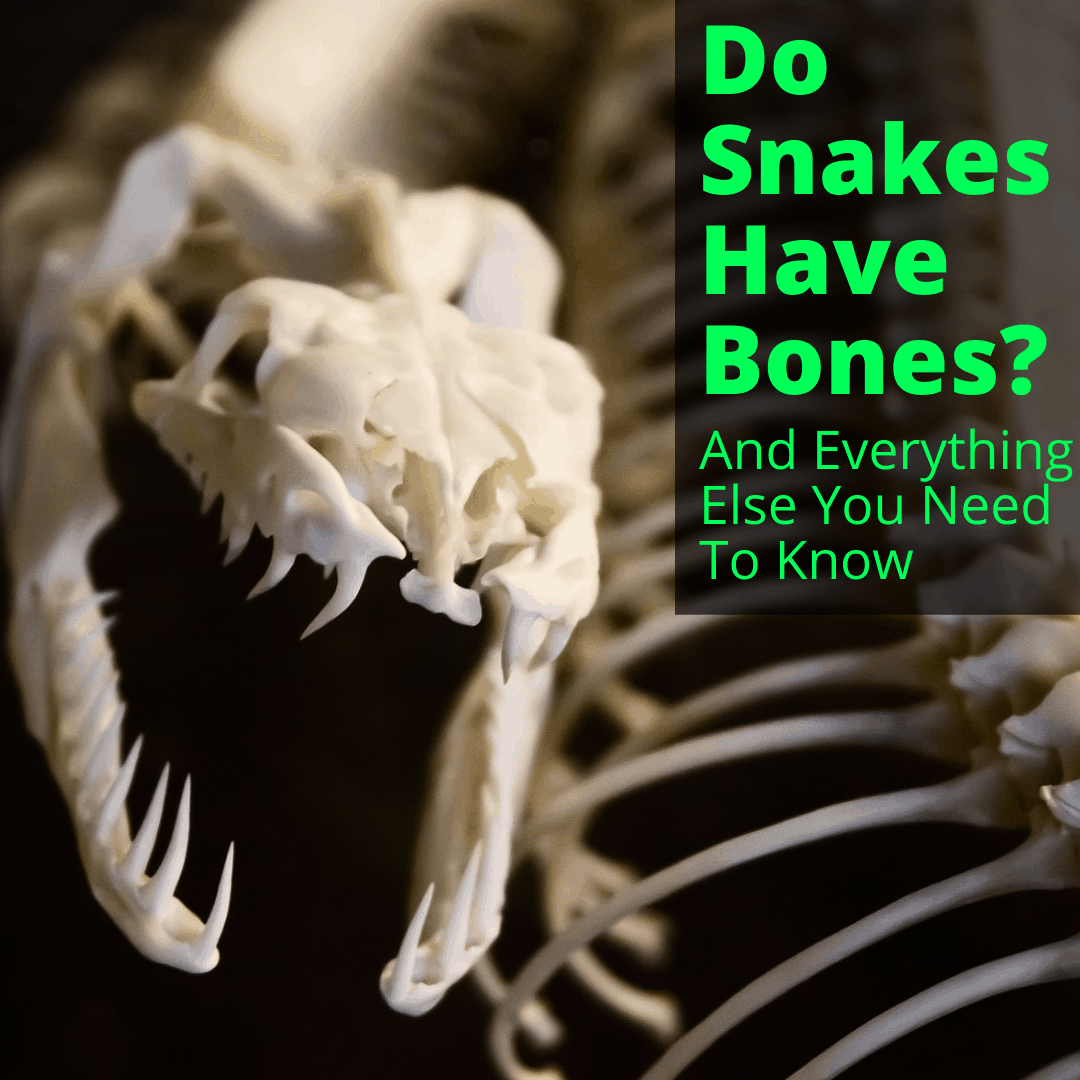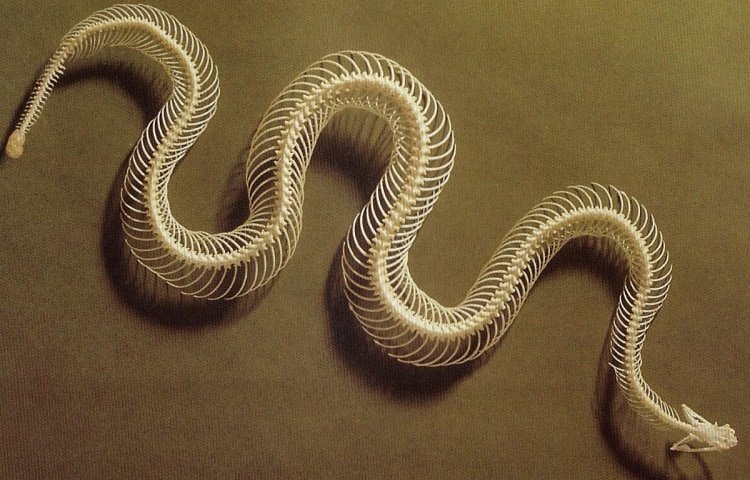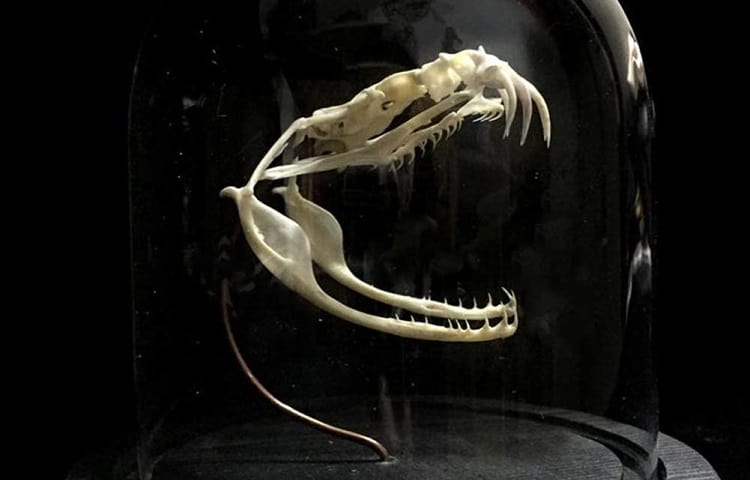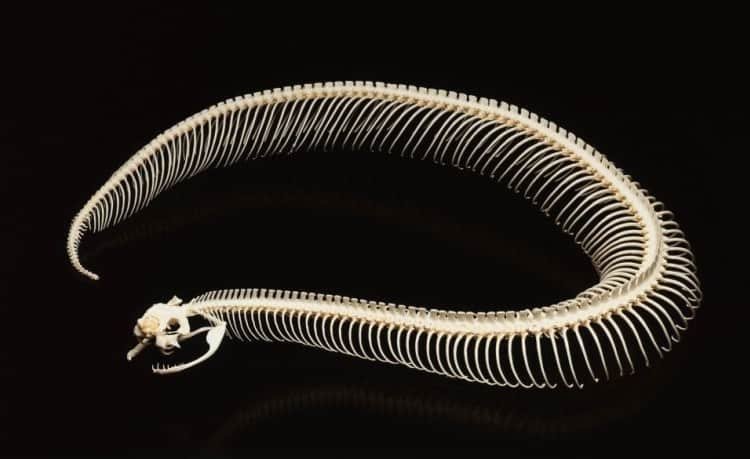
Probably a long, thin, wiggly creature that is incredibly agile and flexible.
In other words, not the kind of animal that has a lot of bones.
Bones would give it a more rigid structure after all, right?
But snakes do have bones. A lot of them, in fact.
Keep reading to learn everything you need to know about snake bones, from how many they have, to how they function to allow for a snake’s incredible flexibility.
Table of Contents
Do Snakes Have Bones?
Snakes have bones and they need them in order to be strong and flexible. How else would they be able to wrap themselves around tree branches or climb walls?
They have a skull and a long spine that consists of hundreds of vertebrae. Depending on the species, snakes have between 180 and 400 bones! Some larger species can have a lot more than that.
They also have hundreds of ribs all the way down their bodies which serve to protect their organs. They have a pair of ribs connected to every vertebra, except for those in the tail.
These ribs form a sort of cage that protects their bodies and organs, similar to our rib cage.
How Snake Bones Function

You might wonder how so many bones can fit inside a snake’s thin body. The secret is that a snake’s ribs do not join together on the bottom of their bodies. They don’t touch and they have the ability to spread apart.
This is how snakes can increase their size to accommodate an especially large meal. This rib expansion is similar to the way snakes widen and extend their jaws when they swallow large prey whole.
If you had x-ray vision and took a look inside a snake’s body to see its skeleton, you would first notice the ribs, vertebrae, and jawbones.
The ribs attach to each of the vertebrae (not in the tail, though), and you’d see bony vertebrae projections on both the front and back of the backbone. These help to lock the end vertebrae in place to give the snake more flexibility, without its bones slipping out of place.
Snakes have spines that are made out of flat and wide bones. These are joined together by cartilage. The spinal column protects the spinal cord, as it does in mammals.
Snake Skulls

Snakes have very interesting skulls. They are made up of separate bones, and their upper and lower jaws are split into two parts.
The bones are linked by flexible ligaments but they don’t slot or lock into place like other animal skulls. This means that a snake’s skull is flexible. This is what allows their jaws to stretch widely, in order to swallow their prey whole.
Not only can they move their jaws up and down and stretch in this direction, but they can also move both the right and left side of their jaws independently from each other!
This is what allows them to push large prey into their mouths so that they can swallow and digest it with ease. Not only that, but their jawbones also pick up vibrations in the ground, which is how snakes hear sound.
Do Snakes Have A Pelvis?
Snakes used to have pectoral arches but they lost these as a result of evolution. Modern snakes do not have hips or pelvises.
They may not have pelvises, but it’s interesting to note that some snake species do still have an outline of where the pubis used to be.
Boas and pythons are good examples. This gives them a somewhat narrow appearance at the pelvis and pectoral area. The long but thin Amazon Tree Boa size is a good example.
Can Snakes Break Their Bones?

Since they have many bones in their bodies, it is only logical to wonder if snakes can break their bones like we can. Can they suffer fractures or other injuries?
It actually takes a lot for a snake to break one of its bones, because of its flexible attachments. That said, it’s not impossible for a snake to break its bones. It can even break its back.
When this happens, it’s usually as a result of injury. Perhaps the snake is small and something or someone stepped on it.
A snake with a broken back will have a visible kink in its body. It will be unable to move properly in the area of the break or fracture.
If any of these symptoms ever apply to your snake, you need to get it to an exotic pet vet immediately.
Related Questions
How do bones help snakes move around?
Since snakes don’t have any arms or legs, their skeletons are what help them to get around. Their spines are flexible and their many ribs all the way down their bodies are what help them bend and curl when they move. And some snakes can move surprisingly fast!
How many bones does a Burmese python have?
Since snakes have a set of ribs for every vertebra, larger snakes obviously have more bones. The Burmese python has an amazing 872 bones in its body.
Even longer snakes, like a giant python, can easily have over 1,500 bones.
Snake Bones: Conclusion
The sleek way snakes move and the sheer flexibility makes the question “do snakes have bones?” perfectly understandable. And it should come as no surprise that many people think they do not.
They look and move in a similar manner to worms, so it makes sense their anatomy might be the same. In other words: no bones.
But now you know that’s not the case. Snake do indeed have bones in their bodies. In fact, they have lots of them!
And the larger the snake, the more bones it has. Because larger snakes need more bones.
They not only serve to protect the snake’s organs from injury, but also help it to be more flexible while giving it the support it needs to climb, crawl, and even eat large prey.
Leave a Reply